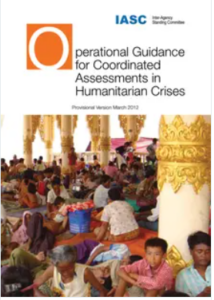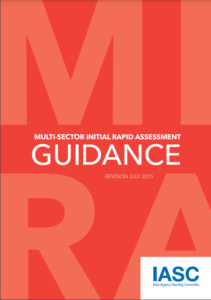Needs Assessments and Analysis
Overview
A coordinated approach to the needs assessment and analysis in an emergency and to the prioritisation of the needs of affected people lays the foundation for a coherent and efficient humanitarian response. It helps improve the quality, comparability, and evidence-base for such response. Needs assessments and analysis are carried out in partnership by humanitarian actors and document the scope of a particular crisis. More importantly, coordinated assessments illustrate the needs of affected populations and informs strategic response planning and system-wide monitoring.
For protracted crises, the depth and volume of information needed for an effective response increase as the response evolves. This often translates into a requirement for in-depth cluster/sector, thematic or agency-specific assessments to inform planning and operations, which in turn necessitates a harmonized assessment approach with joint needs analysis.
Needs assessments and analysis follow the principle of humanitarian accountability and can enhance the quality of inter-agency collaboration. They can also improve donor funding levels and relationships with governments, local NGOs, and disaster-affected populations. Humanitarian Country Teams (HCTs) benefit from using coordinated assessments when responding to a disaster.
Evidence-base
Needs assessments and analysis provide the evidence-base for strategic planning, as well as the baseline information upon which situation and response monitoring systems will rely. It should therefore form a continuous process throughout the Humanitarian Programme Cycle (HPC).
Coordinated assessments are carried out in partnership with all humanitarian actors in order to assess the humanitarian situation and to identify the needs of the affected population. Local and national authorities, civil society and affected communities are encouraged to participate in this process, the output of which is a Humanitarian Needs Overview (HNO).
Key outputs: Humanitarian Needs Overview and Humanitarian Dashboard
HNOs should be produced twice a year to support the Humanitarian Country Team (HCT) in developing a shared understanding of the impact and evolution of a crisis and to inform response planning. This document presents a comprehensive analysis of the overall situation and associated needs. It is structured along the analytical framework developed for the Multi-Cluster/Sector Initial Rapid Assessment (MIRA).
The HNO builds and expands upon the needs analysis chapter of the former Consolidated Appeal Process (CAP) document, consisting of a discrete step in the implementation of the programme cycle. Its development is a shared responsibility among all humanitarian actors, requiring strong collaboration between programme and information management staff as well as support from the OCHA country office and the inter-cluster coordination mechanism.
In addition to the HNO, each country will continue to produce a humanitarian dashboard to present data on needs, response monitoring, and gaps per crisis in an easily digestible format, based on the information presented in the humanitarian needs overview.
For more information visit the JIAF web page.
Guidance and Templates
Below you will find a collection of key guidance and templates supporting the production of Needs Assessment-related output.
Humanitarian Needs Overview
This output is designed to support the Humanitarian Country Team in developing a shared understanding of the impact and evolution of a crisis. The humanitarian needs overview helps inform strategic response planning. Most importantly, it works to ensure that credible evidence and a joint analysis of needs underpin an effective and prioritised humanitarian response.
Available in several languages, the HNO annotated template is available under the HPC Facilitation Package.
All HNOs are available here.
IASC Operational Guidance on Coordinated Assessments in Humanitarian Crises
Identifying priority needs of affected populations is the first step towards ensuring an effective and speedy humanitarian response. The Operational Guidance promotes a shared vision of how to plan and carry out coordinated assessments. Outputs from coordinated assessments support humanitarian decision-making.

MIRA Guidance
The MIRA Guidance outlines an approach to undertaking a joint multi-sectoral assessment in the earliest days of a crisis or change in the context. It guides subsequent in-depth sectoral assessments and provides decision-makers with timely, adequate, sufficiently accurate and reliable information to collectively identify strategic priorities. More information can be found here.

Data Collection Tools
Kobo Toolbox
Kobo Toolbox was created to be a free and accessible data collection tool for organizations in the humanitarian, development, environmental protection, peacebuilding, and human rights sectors. Kobo Toolbox is the main tool used by humanitarian organizations for primary data collection. Kobo allows users to quickly build questionnaires using a number of quantitative and qualitative question types and to collect data offline or online on mobile phones or web browsers. More information can be found here.
The Data Entry and Exploration Platform (DEEP)
DEEP is used for Secondary Data Review (SDR). It offers a suite of tools and collaborative workflows that meet the needs for compiling, storing and structuring data and qualitative information. More information can be found here.
Joint Intersectoral Analysis Framework (JIAF)
JIAF provides humanitarian actors with a common analytical framework and system to gather, structure, and synthesize information regarding the needs of populations in crisis.
The JIAF offers a methodological approach and a structured sensemaking process to support regular joint needs analysis through:
- Supporting the collation, analysis and storage of data
- Providing a way to organize what data to collect and how to analyze it;
- Guiding a joint analysis process involving multiple stakeholders;
- Serving as a driver for collaboration between humanitarian actors
The purpose is to help inform the decision-making process when planning a coordinated response through a people-centred, and inclusive joint intersectoral analysis system that is both comprehensive and methodologically rigorous.
The findings of the JIAF are presented Humanitarian Needs Overview (HNO) which in turn helps inform the humanitarian response plan (HRP). For more information about JIAF please visit this website.
Assessment Registry
A humanitarian needs assessment registry functions as a centralized database specifically designed to track and store information pertaining to needs assessments carried out in response to crises.
To learn more about the Assessment registry tool used by OCHA, click here.